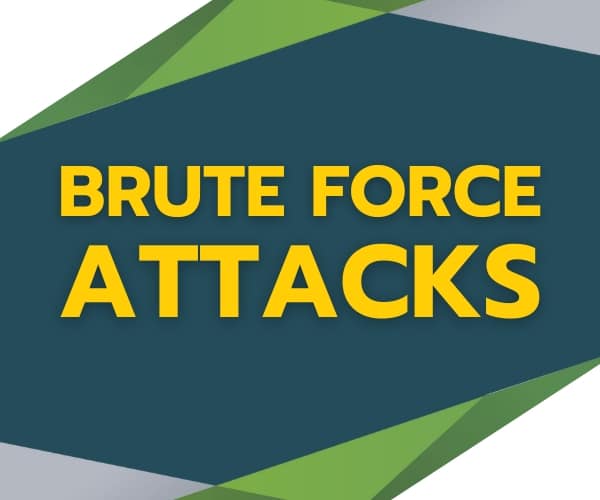In my travels and discussions with clients and prospects alike, I find one of the most common forms of attack is what’s known as “brute force cyber attacks”. These attacks target weak passwords and unsecured systems, and while they may seem simplistic on the surface, their potential for disruption and damage is significant. For businesses, it’s crucial to understand what brute force cyber attacks are, the impact they can have, and, most importantly, the strategies that can help protect against them.

What is a Brute Force Cyber Attack?
A brute force cyber attack is a method used by cybercriminals to gain unauthorized access to a system, network, or account by systematically guessing passwords, encryption keys, or PINs. The attacker uses automated software to try thousands—or even millions—of combinations until the correct one is found. This method of attack leverages the sheer power of computing to crack passwords by trial and error, often targeting weak, short, or commonly used passwords.
Brute force cyber attacks come in several forms, including:
- Simple Brute Force Cyber Attack: The attacker tries every possible password combination until the correct one is found. This can take a long time, especially for complex passwords, but is highly effective against weak passwords.
- Dictionary Attack: The attacker uses a predefined list of likely passwords or commonly used password combinations (such as “123456” or “password”) to speed up the process.
- Credential Stuffing: Cybercriminals use credentials obtained from a previous data breach to attempt to gain access to accounts on different websites, banking on users’ tendency to reuse passwords.
- Hybrid Brute Force Attack: This combines both a dictionary attack and a simple brute force approach by first using known words or password fragments and then applying brute force techniques to modify them.
Impact of a Brute Force Cyber Attack on a Business
The impact of a brute force cyber attack on a business can be far-reaching, affecting both the company’s security and its reputation. Some of the major impacts include:
Data Breaches and Financial Losses
Once attackers successfully crack a password, they can gain access to sensitive data, proprietary information, or customer records. This can lead to significant financial losses, including theft of funds, intellectual property, or the cost of remediation efforts after a breach. For instance, in industries like finance, healthcare, or e-commerce, a compromised account can allow attackers to steal payment details, personal health information, or other valuable data.
Operational Disruptions
Brute force cyber attacks can overwhelm systems with repeated login attempts, causing slowdowns or even service outages. In some cases, attackers use brute force techniques in combination with distributed denial-of-service (DDoS) attacks, which can bring business operations to a standstill. For online businesses, such disruptions can lead to lost sales, damaged relationships with customers, and costly downtime.
Damage to Brand Reputation
Customers and stakeholders expect businesses to keep their data secure. A successful brute force cyber attack leading to a data breach can severely harm a company’s reputation, eroding trust and potentially leading to customer churn. Recovering from a breach often involves notifying affected customers, offering credit monitoring services, and investing in public relations efforts to restore brand confidence—all of which can be costly and time-consuming.
Legal and Regulatory Consequences
Depending on the nature of the data compromised in the attack, businesses could face legal action or regulatory fines, especially under data protection laws like the GDPR, CCPA, or HIPAA. Failing to secure personal or sensitive information adequately can lead to hefty penalties, especially if it is found that the company did not take reasonable steps to protect its systems.
7 Methods to Protect Against Brute Force Cyber Attacks
Given the widespread use of brute force techniques and the damage they can cause, businesses must take proactive steps to prevent and mitigate these attacks. Here are some of the most effective methods:
Use Strong, Complex Passwords
Encouraging or enforcing the use of strong passwords is one of the most basic yet effective defenses against brute force cyber attacks. Passwords should be long (at least 12-16 characters) and should include a mix of uppercase and lowercase letters, numbers, and special characters. Additionally, passwords should not be easily guessable (e.g., “password123” or “admin”), and users should avoid using personal information, like names or birthdates.
Implement Multi-Factor Authentication (MFA)
Multi-factor authentication is a critical line of defense against brute force attacks. Even if an attacker successfully guesses a password, MFA requires an additional verification method, such as a one-time passcode sent to a mobile device or biometric authentication (fingerprint, facial recognition). This extra layer of security can prevent unauthorized access even if the password is compromised.
Set Account Lockout Policies
To reduce the effectiveness of brute force attacks, businesses can implement account lockout policies. After a specified number of failed login attempts (e.g., five tries), the account is temporarily locked or disabled for a set period. This limits the number of password guesses an attacker can make, making brute force attacks much less feasible. However, account lockouts should be configured carefully to avoid inconveniencing legitimate users or creating opportunities for denial-of-service (DoS) attacks.
Use CAPTCHA or Other Challenges
CAPTCHAs and other challenges are designed to verify that login attempts are being made by humans rather than automated bots. By adding a CAPTCHA to the login process, you can thwart automated brute force tools, which struggle to solve these puzzles. This technique adds a barrier to brute force attacks without significantly impacting the user experience.
Regularly Monitor and Limit Failed Login Attempts
Businesses should actively monitor failed login attempts and set alerts for unusual login patterns. This can help detect a brute force attack in progress, allowing IT teams to intervene before significant damage is done. Limiting login attempts based on IP addresses or regions, or using tools to detect and block suspicious IP addresses, can also help protect against these attacks.
Encrypt Passwords
In the event that a brute force attack is attempted against a database of stored passwords, proper encryption techniques make it exponentially harder for attackers to crack the passwords.
Keep Systems Updated
Regularly updating software and security protocols ensures that any vulnerabilities that could be exploited by attackers are patched. This includes updating web applications, servers, and firewalls to reduce the risk of brute force attacks or other security exploits.
Brute force attacks are a straightforward yet dangerous method used by cybercriminals to breach business systems and access sensitive data. The impacts of such attacks can be devastating, leading to financial losses, operational disruptions, damage to a company’s reputation, and potential legal consequences. However, by implementing a combination of strong passwords, multi-factor authentication, account lockout policies, and monitoring tools, businesses can significantly reduce their vulnerability to these attacks. Staying proactive in cybersecurity and regularly updating security practices will help protect your business against brute force attacks and other cyber threats.

Chris Montgomery
ThrottleNet Sales Director
cmontgomery@throttlenet.com



